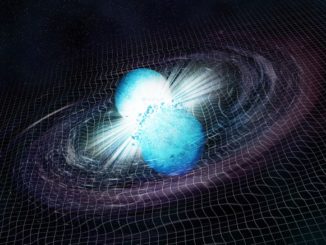
Some 15,000 light years from Earth, a huge star with 30 times the mass of the Sun and a black hole weighing in at 10 to 20 solar masses orbit each other every 13 days in a system known as SS 433. The black hole is pulling mass away from the companion star, feeding an off-axis accretion disk and polar jets that wobble, or precess, with a period of about 162 days.
Given its scaled-down resemblance to the supermassive black holes found in the hearts of active galaxies, SS 433 is known as a “microquasar.”
An international team of researchers led by Jian Li, a Humboldt Fellow with Deutsches Elektronen-Synchrotron (DESY), and Diego F. Torres with Spain’s Institute of Space Sciences studied 10 years of observations by NASA’s Fermi gamma ray space telescope and found a gamma-ray signal from a gas cloud some 100 light years from SS 433 that pulsates with the same period.
“Finding such an unambiguous connection via timing, about 100 light years away from the microquasar, not even along the direction of the jets is as unexpected as amazing,” said Li. “But how the black hole can power the gas cloud’s heartbeat is unclear to us.”
Animation: Animation: DESY, Science Communication Lab
Periodic illumination by one of the jets appears unlikely. But it may be the result of fast-moving protons near the black hole that are injected into the jet and then slam into the cloud, producing gamma rays. It’s also possible fast protons from the edge of the black hole’s accretion disc are funnelled into the cloud.
“Energetically, the outflow from the disc could be as powerful as that of the jets and is believed to precess in solidarity with the rest of the system,” said Torres.
The research was reported in the journal Nature Astronomy.
“SS 433 continues to amaze observers at all frequencies and theoreticians alike,” said Li. “And it is certain to provide a testbed for our ideas on cosmic-ray production and propagation near micro quasars for years to come.”



